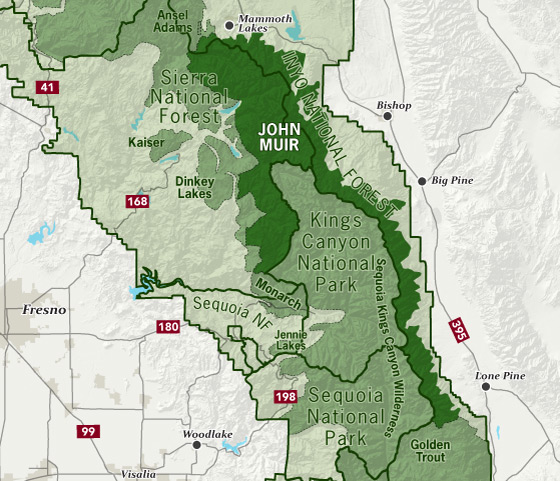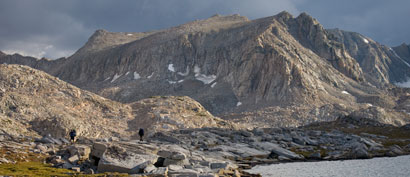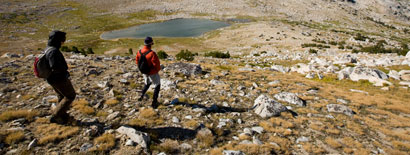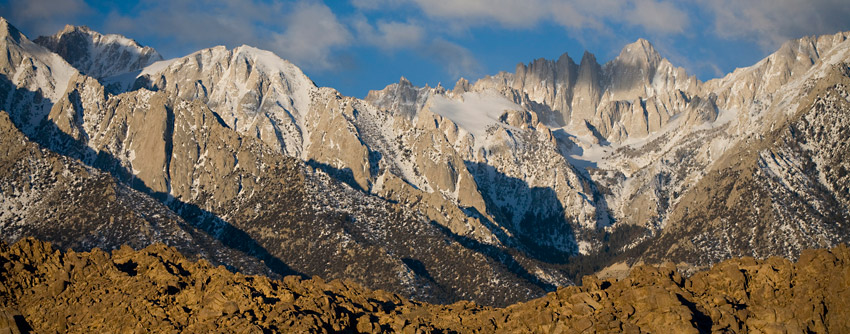
Named after one of the Sierra’s most dedicated advocates, the John Muir Wilderness consists of more than half a million acres, bringing together some of the most spectacular landscape in the Sierra Nevada. It was designated in the 1964 Wilderness Act and contains the highest peak in the lower 48 states: Mt. Whitney at 14,494 feet. In addition to granite peaks and glacially carved canyons, the John Muir protects the headwaters of the South and Middle Forks of the San Joaquin River, as well as the North Fork of the Kings River.

Entering the John Muir Wilderness from the east side, near North Lake above Bishop
GETTING THERE
The John Muir Wilderness is approachable from both sides of the Sierra Nevada. Most visitors, however, enter from the east at various points along highway 395, from the town of Mammoth at the north end down to Whitney Portal above Lone Pine at the south end. See the sidebar for public transportation options.
WILDERNESS PERMITS
Permits are required for all overnight trips in the John Muir Wilderness, and all trailheads have quotas. Why? Quotas apply to all overnight visitors, whether you use the services of a commercial outfitter/guide or not.
Wilderness Permits are available from the Sierra and Inyo National Forests, depending on where you plan to enter the Wilderness.
MT WHITNEY PERMITS
As the tallest peak in the lower 48 states, Mt Whitney is a popular destination. In order to preserve this area as a wilderness, permits are required for all all multi day trips and day use in the “Whitney Zone." All the info you’ll need is available from the Inyo National Forest.

MAXIMUM GROUP SIZE
No more than 15 people and 25 head of stock are allowed per group on overnight trips. Why?
BEARS AND FOOD STORAGE
The Inyo and Sierra National Forests each have a forest order regarding food storage. In all wilderness areas of Inyo National Forest use of bear-resistant containers is strongly recommended. In eight specific areas it is mandatory to store food and refuse in a container designed to prevent access by bear. Where food storage containers are not mandatory the counter balance method of hanging food may be used, however where trees are not adequate for hanging food at least 15 feet above ground and 10 feet away from the tree trunk you must use a portable food storage container. No other methods of food storage are allowed.
Food storage containers are available for rent or sale at all the Inyo and Sierra National Forest visitor centers where wilderness permits are issued.
See also:
- Inyo National Forest Food Storage Info
- Sierra National Forest Food Storage Info
- Counter-balance method
CAMPFIRES
Campfires are generally allowed within the John Muir Wilderness below “tree line” (around 10,000 feet), though there are exceptions. Check campfire regulations in the Inyo National Forest and Sierra National Forest for specifics.
In places where fires are allowed, make sure to always follow smart campfire guidelines.

Heading down from Piute Pass, near Desolation Lake in the John Muir Wilderness
PETS
- Pack goats are not recommended in Big Horn Sheep habitat areas while their impacts are being evaluated. For more information about Big Horn Sheep recovery, check the following links: Sheep Facts Big Horn Recovery
- Dogs are allowed in the John Muir Wilderness, but are not allowed in wilderness areas in adjacent national parks.
- Pet food must be stored to the same standard as people food. In areas where use of a bear resistant food storage container is required, pet food must be stored in your container.
- Leashes protect dogs from becoming lost and from wilderness hazards such as porcupines, mountain lions, and sick, injured or rabid animals.
- Unleashed dogs may intimidate other hikers and their dogs, depriving them of a peaceful wilderness experience.
- Unleashed dogs may harass, injure and sometimes kill wildlife.
- A leashed dog’s keen senses can enhance your awareness of nearby wildlife or other visitors.
OTHER CONSIDERATIONS
- Camping is prohibited: within 300 ft. of the outlet of Duck Lake and Purple Lake; at Mirror Lake and Trailside Meadow on the Main Mt. Whitney Trail; within 500 feet of Golden Trout Lake (Sierra NF); with pack and saddle east of Shepherd Pass.
- Fishing is a popular activity in the John Muir Wilderness, even though trout are not native to most of the lakes and streams. A California fishing license is required for everyone aged 16 and older. Licenses are available online, as well as at many stores and resorts near departure trailheads. Fishing season is open from the last Saturday in June through November 15 unless otherwise restricted. Bag limit is 5.
- Fishing at Cottonwood Lakes 1, 2, 3, and 4 must be catch and release only. All other lakes in the Cottonwood Lakes Basin are restricted to artificial lures or flies with barbless hooks, limit 5. Season is July 1 – November 15.
- Fishing at Laurel Lakes is limited to 14 in minimum length, artificial lures or flies with barbless hooks, limit 2. Season is last Saturday in June – November 15.
- Fishing at McLeod Lake is catch and release only, limit 0. Only artificial lures or flies with barbless hooks.
